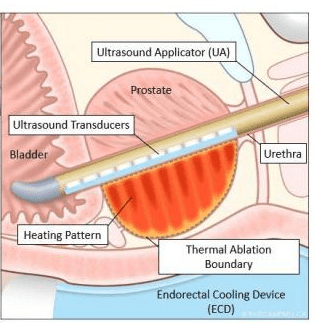The treatment does not require an incision and could also be used to treat benign enlargement of the prostate gland.

Prostate cancer is one of the most lethal forms of cancer. Most prostate cancers are slow-growing, although they can also take a long time to be detected, and men tend to ignore symptoms until they become very serious (yes, if you’re thinking that’s you, you should have that checked out).
Treatment can be very effective if detected early, but it can also be very painful and difficult. With this in mind, a team of researchers has designed a new, minimally-invasive way to remove prostate cancers.
The technique involves sophisticated imaging guidance and temperature monitoring to deliver precise doses of sound waves to diseased prostate tissue while leaving healthy tissue unaffected.
The system, called TULSA, features a rod-shaped device with 10 ultrasound-generating elements that can cover the entire prostate gland. The surgeon decides which of the elements are fired, sending out a combination of soundwaves and heat to target cancerous tissue. The entire procedure takes place in an MRI scanner so that doctors can closely monitor treatment and assess the degree and location of heating.
“Unlike with other ultrasound systems on the market, you can monitor the ultrasound ablation process in real time and get immediate MRI feedback of the thermal dose and efficacy,” said study co-author Steven S. Raman, M.D., professor of radiology and urology at the University of California at Los Angeles (UCLA). “It’s an outpatient procedure with minimal recovery time.”
“There are two very unique things about this system,” Dr. Raman continued. “First, you can control with much more finesse where you’re going to treat, preserving continence and sexual function. Second, you can do this for both diffuse and localized prostate cancer and benign diseases, including benign hyperplasia.”
In a study to assess the effectiveness of the procedure, clinically significant cancer was eliminated in 80% of the study participants, and 65% had no evidence of cancer after one year. There were no bowel complications and overall, the negative symptoms were very low.
“We saw very good results in the patients, with a dramatic reduction of over 90 percent in prostate volume and low rates of impotence with almost no incontinence,” Dr. Raman said.
So far, TULSA has been approved for treatment in Europe, and has also received FDA 510(k) clearance for prostate tissue ablation in the United States. If the initial tests are confirmed, it could become an important tool in treating prostate cancer, as well as the benign enlargement of the prostate, which can often degenerate and lead to complications — including prostate cancer.
The results have been presented at the 105th Scientific Assembly and Annual Meeting of the Radiological Society of North America.



